The Sept. 11 attacks on American civilians have brought on a new type of warfare, with an elusive enemy and an indefinable battleground.
Several Malibu veterans gave their perspective on this new type of war, and the methods with which to fight it.
While all agreed this is a battle that must be fought, some feel the enemy needs to be more clearly defined.
“We ought to reciprocate when we know who it is,” said Doug O’Brien, a Korean War veteran who served on a submarine.
The toughest part is finding out who it is. “If Bin Laden is guilty, we ought to capture him,” said O’Brien. “Furthermore, if some countries support the terrorist groups, we ought to do something about them too. They can’t go on unpunished.”
“We had a more definite picture of who we were fighting against than we do today,” said Gordon Arford, president of the Malibu Navy League, who served in the Korean War.
“This time it’s not necessarily a military-to-military gun battle, it’s a smoke screen,” he said.
Despite an unseen enemy, the threat is real and most Americans do not see a call-to-arms unfavorably.
In contrast with the Gulf war, this time the enemy appears to be more of a real threat because it is closer, said Patrick O’Brien, Gulf war veteran and son of Doug O’Brien. Patrick is now a commercial airline pilot for Southwest Airlines. On Sept. 11, O’Brien was in the air flying over the East Coast.
“It doesn’t surprise me that Americans have become more resolved,” he said.
However, Americans are waiting to see what form this war will take.
“This can be called a war because civilians have been attacked, but it’s going to be a different kind of war,” said Jeff Jennings, a Vietnam veteran and Malibu city councilmember. “But it’s not going to be easy. There is no particular national enemy we have to face; this is not a war against a country. Afghanistan just happens to be the place where Osama bin Laden is hiding out.”
The United States is clearly seeking Bin Laden as the number one priority, concurred Todd Sloan, a Vietnam War veteran who served in the Marines.
The focus is also on other radical Islamic groups, but, “are we going to treat all terrorist groups as terrorist groups or only the ones we don’t like?” asked Sloan, referring to the IRA and other similar groups.
This offensive cannot be relative; it’s got to be total, he said. A global ban on terrorism should be implemented, he suggested.
As for the tactics that are already being used in this war, cutting off financial support to the terrorists is already underway.
“This is not a conflict that requires the smashing of the walnut with a sledgehammer, instead they are attempting to dry up the funding for the terrorists,” said Sloan.
Military personnel resources also appear to be used more strategically.
“I think war changed dramatically after Vietnam,” said Sloan. “The philosophy of the battlefield moved more and more toward the high-tech world. We learned by virtue of having an all-volunteer and smaller force that we have to use our greatest asset–technology.
“There may be small teams operating in various countries, but the distinction between Vietnam and now is that in Vietnam, the U.S. saturated the entire country with American presence. Now we use recognizance and eyes for deployment. You want to put as few people as possible in harm’s way.”
After years of federal military budget cutbacks, priorities may also change to the satisfaction of the Navy League, which believes the Navy is short of warships.
“But the Navy is short of ships right now,” said Arford, who believes the U.S. Navy needs about 300 more ships to adequately defend the nation.
Despite the attacks, Arford’s confidence in the Navy remains unshattered; he still believes it is America’s first line of defense. “They are the people who go in right away,” he said.
But the impacts of the attacks on America are not only military; they permeate our daily lives. People worry about possible future attacks.
Biological and nuclear threats are not different than they were before this particular attack, said Patrick O’Brien. “These people are looking for the effect, what will get them on national news.”
“It’s terrible that we can’t continue our lives in a free country without being concerned about who is sitting next to us,” said Doug O’Brien. “We should close our borders so we don’t get undocumented aliens in this country from any country.”
The unified support of U.S. leaders’ decisions is also uplifting to the veterans.
Doug O’Brien said he trusts President Bush is doing the right thing and he has good people around him to guide him.
“I was not able to see the patriotism back home when I was deployed,” said son Patrick. Now, “it makes me proud to be an American.”

